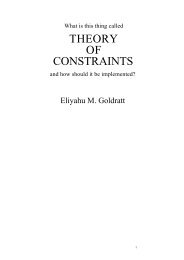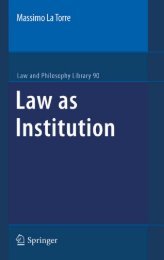Making of a German Constitution : a Slow Revolution
Making of a German Constitution : a Slow Revolution
Making of a German Constitution : a Slow Revolution
Create successful ePaper yourself
Turn your PDF publications into a flip-book with our unique Google optimized e-Paper software.
256 • The <strong>Making</strong> <strong>of</strong> a <strong>German</strong> <strong>Constitution</strong>Here, he has emphasized the recovery <strong>of</strong> the Nibelungenlied and the importance <strong>of</strong>the Grimm brothers’ fairy tales. 18 <strong>German</strong>ist scholarship embodied nothing less thana modern process <strong>of</strong> rationalization, systematization, pr<strong>of</strong>essionalization and scientization<strong>of</strong> <strong>German</strong> customs as a basis for <strong>German</strong> rules <strong>of</strong> laws, none other thanthe political element. At the same time, there was a strong creative, almost künstlichdimension in the development <strong>of</strong> envisioning a <strong>German</strong> Gemeinwesen. The mobilizationand drive for constitutional transformation was sustained at the popular levelby <strong>German</strong> fairy tales, which Grimm believed contained the remnants <strong>of</strong> ancient<strong>German</strong> law and customs from the free epoch. This critical detail leaves one withan understanding that the moral <strong>of</strong> the Grimm’s brothers’ stories impressed liberalsociopolitical and constitutional values in the popular mind.Nowhere is the link between constitutionalism and art made clearer than in theconsideration <strong>of</strong> the formidable influence <strong>of</strong> Jacob Grimm on the development <strong>of</strong>Privatrechts-Staatslehre, namely the growth <strong>of</strong> legal antiquarianism. He also emphasizedthe primacy <strong>of</strong> the people as the source <strong>of</strong> law, but called for greater consideration<strong>of</strong> the sinnliche element. In poetry, language, and fairy tales, Grimm claimedto find remnants <strong>of</strong> private law, from the so-called ancient <strong>German</strong> free epoch. Heargued that a Lebendigkeit, or organic relationship, existed between contemporaryfolklore and ancient <strong>German</strong> law, and, as I have argued, this marked the growth <strong>of</strong> a<strong>German</strong> common law constitutionalism. His Rechtsalterthümer proved to be one <strong>of</strong>the most influential texts in <strong>German</strong> legal development and <strong>of</strong>fered a glimpse <strong>of</strong> theimagined Gemeinwesen. While he clearly outlined the structure <strong>of</strong> a <strong>German</strong> publicspace in a free society, his descriptions <strong>of</strong> social relations defined the parameters <strong>of</strong>that public space in such a way that it depended on dichotomous formations, whichmade inclusion and exclusion interdependent.The organization <strong>of</strong> the family—and particularly gender relations—was a centralfeature in the <strong>German</strong>ists’ writings. Gender relations became the central metaphorfor power relations in public society, and here the capacity for the independent ownershipand distribution <strong>of</strong> property was a principal concern. A significant portion <strong>of</strong>Rechtsalterthümer was concerned with private relationships, yet these relationshipswere politically significant. This pattern <strong>of</strong> political development continued to beevident in the writings <strong>of</strong> important liberal legal scholars, such as Karl Mittermaier,A. L. Reyscher, Friedrich Dahlmann, and Georg Beseler, and it reemerged in theplatforms <strong>of</strong> the <strong>German</strong>isten conferences that were held in 1846 and 1847. <strong>Constitution</strong>altransformation, for these reasons, was as concerned about the social questionas it was about political transformation. As a result, social transformations, suchas the reorganization <strong>of</strong> family relations, also emerged as an important measure <strong>of</strong>revolution; installing the bürgerliche family as the basis <strong>of</strong> society was a part <strong>of</strong> therevolutionary strategy from the outset.By the late 1840s constitutional transformation had emerged as a programaticstrategy for political revision. Georg Gervinus wrote to Friedrich Dahlmann in 1847that it would be their place ‘to achieve the advantages <strong>of</strong> political revision without




